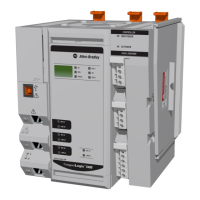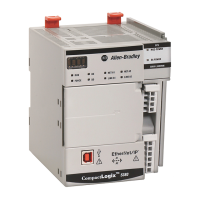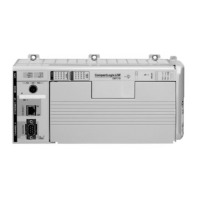Rockwell Automation Publication 5069-IN019C-EN-P - October 2018 3
CompactLogix 5480 Controller
Environment and Enclosure
ATTENTION: This equipment is intended for use in a Pollution Degree 2 industrial environment, in overvoltage Category II applications (as defined in EN/IEC
60664-1), at altitudes up to 2000 m (6562 ft) without derating.
This equipment is not intended for use in residential environments and may not provide adequate protection to radio communication services in such
environments.
This equipment is supplied as open-type equipment for indoor use. It must be mounted within an enclosure that is suitably designed for those specific
environmental conditions that will be present and appropriately designed to prevent personal injury resulting from accessibility to live parts. The enclosure must
have suitable flame-retardant properties to prevent or minimize the spread of flame, complying with a flame spread rating of 5VA or be approved for the
application if nonmetallic. The interior of the enclosure must be accessible only by the use of a tool. Subsequent sections of this publication may contain more
information regarding specific enclosure type ratings that are required to comply with certain product safety certifications.
In addition to this publication, see the following:
• Industrial Automation Wiring and Grounding Guidelines, publication
1770-4.1, for more installation requirements.
• NEMA 250 and EN/IEC 60529, as applicable, for explanations of the degrees of protection provided by enclosures.
Prevent Electrostatic Discharge
ATTENTION: This equipment is sensitive to electrostatic discharge, which can cause internal damage and affect normal operation. Follow these guidelines when
you handle this equipment:
• Touch a grounded object to discharge potential static.
• Wear an approved grounding wriststrap.
• Do not touch connectors or pins on component boards.
• Do not touch circuit components inside the equipment.
• Use a static-safe workstation, if available.
• Store the equipment in appropriate static-safe packaging when not in use.
ATTENTION:
• In case of malfunction or damage, no attempts at repair should be made. The controller should be returned to the manufacturer for repair. Do not dismantle
the controller.
• This equipment is certified for use only within the surrounding air temperature range of 0…60 °C (32…140 °F). The equipment must not be used outside of
this range.
• The USB programming port is intended for temporary local programming purposes only and not intended for permanent connection. The USB programming
port connection is not to exceed 3.0 m (9.84 ft) and must not contain hubs.
• Devices that are connected to USB 3.0 ports must reside in the same control enclosure as the controller. This requirement applies to devices that are powered
by the USB 3.0 ports or not. You must connect the devices to a ground system that is common with the controller. Alternatively, you can connect the device to
the common ground system via a USB hub that provides galvanic isolation.
• USB 3.0 port connections are not to exceed 3.0 m (9.84 ft).
• DisplayPort cables or adapters that are used with this product must be certified by VESA. A list of certified equipment and cables is on the VESA website
(
www.vesa.org). Use of non-certified cables and adapters can cause damage or improper operation. DisplayPort connections are not to exceed 3.0 m (9.84 ft).
• Displays that are connected to DisplayPort must connect to a ground system that is common with the controller. Alternatively, displays can be connected by a
display extender that is connected to the common ground system with the controller and provides galvanic isolation.
• Use only a soft dry anti-static cloth to wipe down equipment. Do not use any cleaning agents.
Electrical Safety Considerations
ATTENTION:
• Do not wire more than 2 conductors on single RTB terminal.
• SELV-listed supplies must be used for MOD and SA power if there are Functional Safety modules connected to the CompactLogix 5480 controller system.
Waste Electrical and Electronic Equipment (WEEE)
At the end of its life, this equipment should be collected separately from any unsorted municipal waste.

